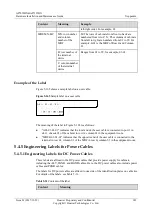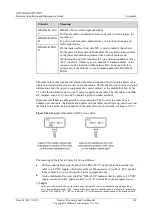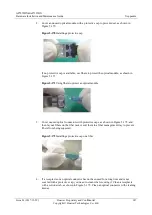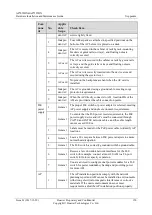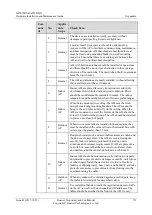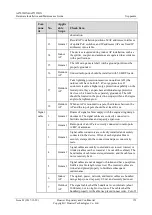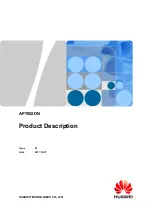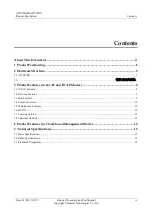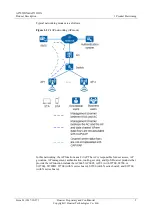
AP7052DN&AP7152DN
Hardware Installation and Maintenance Guide
5 Appendix
Issue 01 (2017-12-29)
Huawei Proprietary and Confidential
Copyright © Huawei Technologies Co., Ltd.
153
Com
pone
nt
No.
Applic
able
Scope
Check Item
redundant cable ties and remove burrs from them to avoid
injuries. The cables shall be fixed using fasteners or
ageing-resistant outdoor metal binding straps.
8
General
Keep the signal cables away from heat sources and use heat
insulation materials to insulate the cables from the heat
sources. Do not place signal cables on the air vents of the
cabinet to avoid affecting subrack heat dissipation or cable
lifetime.
9
General
Pigtail layout should meet the following requirements:
Pigtails are not strained or twisted at the bent parts. They
are bundled by binding tape with appropriate force.
Pigtails can be pulled back and forth easily inside the
cable tie and are not bent at a right angle.
Pigtails are not squeezed by other cables or objects.
The flange must be fixed.
Pigtails are protected with protective tubes or enveloped
in troughs when they are routed outside the cabinet. The
protective tubes are bundled and processed to prevent
cutting.
The optical fiber cannot be folded or twisted, and the
pigtail cannot be squeezed. The binding diameter of an
optical fiber must be larger than 6 cm.
The pigtail connection points must be clean and dustless.
Fiber connectors and optical ports that are not used must
be protected with protective caps or plugs. Cleaning must
be carried out in strict accordance with Huawei tool
specifications.
10
General
The feeder cables shall not be bent or twisted, with no copper
wire exposed.
11
General
The feeder cable connectors comply with corresponding
standards and are correctly connected, without looseness.
12
General
The feeder cables, power splitter, coupler, and surge
protective devices are connected correctly and reliably in
accordance with specifications.
13
General
Strong current and weak current cables are routed separately.
The power cables, ground cables, and signal cables are
bundled and routed separately (with a spacing of more than
30 mm) to prevent electrical or magnetic interference. Use
shielded cables in places with strong interference.
14
General
When routing cables in walls, place the cables in the cable
troughs or pipes and fix the cables using pipe straps. For
non-metal corrugated pipes, the fixing distance should be
about 1000 mm.




